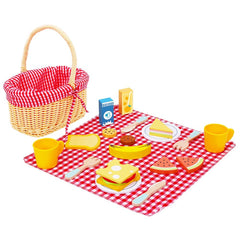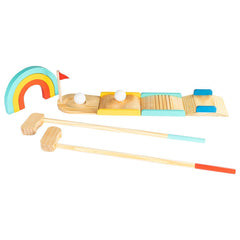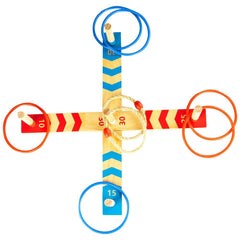In the modern age, finding the right Montessori toys for your child is very challenging because there are various options. Many of these options can break easily or not contribute to your child's growth. This gap can be filled by Montessori wooden toys because they are safe, simple, and educational.
Neither do they flash nor make unnecessary noise. Instead, these toys help kids improve their focus. These baby development toys, crafted from natural materials, provide a screen-free playtime experience. Their benefits go beyond play because they help your child grow in meaningful ways.
Let’s explore more on why Montessori wooden toys are the best educational choice for your child.
Why Montessori Wooden Toys Are the Best Educational Choice
Montessori learning is all about exploring freely, and Montessori wooden toys are perfect for this. They support young children in learning practical skills right away, are open-ended, and are constructed from safe materials.
While plastic toys often distract kids with lights and sounds, the best Montessori toys help children stay focused. They have the freedom to interact, explore, and think independently. The feel of wood is natural and calming, which also supports brain development.
Parents looking for long-lasting learning toys for kids will find value in wooden options. These toys don’t break easily and can be used again and again. They also teach patience, focus, and coordination—making them some of the best educational toys for early development.
Top Montessori Wooden Toys for Babies (6–18 Months)
Babies need simple toys that match their stage of growth. These Montessori wooden toys aid infants in developing early skills.
Wooden Stacking Toys
These teach babies to grasp, release, and stack. They also introduce size and colour differences in a simple way. Wooden stackers support hand-eye coordination and fine motor skills.
Wooden Shape Sorters
Shape sorters are one of the best educational toys. They help babies understand cause and effect. Babies learn to match shapes with holes, which improves problem-solving skills.
Rolling Rattles and Push Toys
These toys move easily and encourage babies to crawl or walk. Babies develop muscle strength and balance while they play. Rolling toys also make soft sounds that keep babies interested without overwhelming them.
Object Permanence Boxes
These toys teach babies that things still exist even when they cannot see them. Dropping a ball into a box and seeing it come out helps babies learn about memory and cause-effect.
Best Montessori Wooden Toys for Toddlers (18 Months to 3 Years)
As children grow, they become more curious. Toddlers love to explore and copy adults. The right learning toys for kids can support this stage well. Here are some examples:
Wooden Puzzles
Simple puzzles teach toddlers about shapes, animals, and everyday objects. They also boost focus and hand control. Wooden puzzles are firm, simple to grip and safe to handle.
Wooden Play Kitchens and Tools
Role play helps toddlers understand daily routines. Wooden kitchen sets and tool kits encourage pretend play. They also teach independence and real-life skills.
Lacing Beads and Threading Toys
These toys improve finger control and patience. Toddlers learn to string a wooden abacus using both hands. It supports fine motor skills and early writing development.
Wooden Counting Boards
Counting toys are among the best educational toys. They teach colour sorting and counting. Toddlers enjoy putting small pegs or discs into the holes while learning.
How Montessori Wooden Toys Help in Early Learning
Montessori wooden toys are designed to match a child’s stage of growth. They are not too simple or too complex. Here are a few ways in which they help in early learning:
1. They support problem-solving
Children learn how to correct mistakes and try again. It builds confidence and independence.
2. They build focus and patience
Without noise and distractions, children learn to concentrate. This is an important life skill.
3. They develop motor skills
Picking, holding, stacking and fitting are all actions that build hand strength. These actions also support writing and drawing later on.
4. They encourage self-paced learning
Children explore at their speed. This leads to more profound understanding and a strong learning habit.
5. They connect with nature
Wooden toys feel close to nature. This creates a calming and peaceful environment for learning.
How to Choose the Best Montessori Toys for Your Child
Choosing the best Montessori toys depends on your child’s age and interests. Here are a few tips:
1. Choose natural materials
Pick toys made from solid wood with smooth edges. Avoid painted or plastic-coated items.
2. Keep it simple
Simple toys encourage deep thinking. Avoid toys with lights, sounds or too many colours.
3. Pick toys with a clear purpose
Every Montessori toy teaches one skill. Choose toys that match your child’s stage of development.
4. Choose open-ended toys
You can use toys like blocks or stackers in many different ways. They grow with your child.
5. Observe your child
See what they enjoy and where they need support. Let their interest guide your choice.
At Barnshenn, we offer a wide range of Montessori wooden toys that fit all these needs. Our products are designed to support child development at every stage.
Conclusion
Ultimately, Montessori wooden toys provide far more than entertainment value. They support your child's growth and build crucial skills like focus and confidence. Their simple designs have a thoughtful purpose behind them. Such simplicity makes them ideal for babies and toddlers alike. When chosen with care, these toys become lasting tools for learning and development.
FAQs –
1. What age is best to start Montessori toys?
Ans: You can start Montessori toys from as early as 6 months. Choose toys that match your child’s current ability and interest.
2. Are Montessori wooden toys safe for babies?
Ans: Yes. They are made from natural materials and have no sharp edges. Always check age recommendations and supervise during play.
3. Do Montessori toys help with learning?
Ans: Yes. They support thinking, problem-solving, hand skills and early math or language comprehension.
4. How many toys should I offer at once?
Ans: It’s best to offer 3 to 4 toys at a time. This approach keeps your child focused and not overwhelmed.





